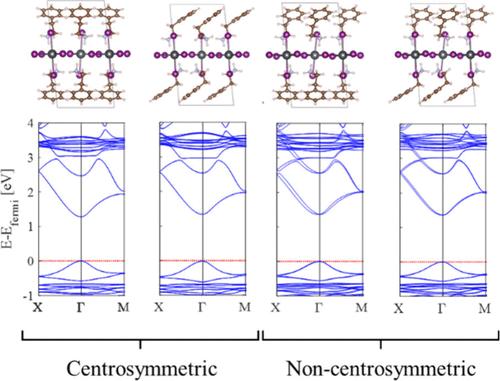当前位置:
X-MOL 学术
›
J. Phys. Chem. Lett.
›
论文详情
Our official English website, www.x-mol.net, welcomes your
feedback! (Note: you will need to create a separate account there.)
Intrinsic Rashba Effect in Stable Configurations of Two-Dimensional (PEA)2PbI4
The Journal of Physical Chemistry Letters ( IF 4.8 ) Pub Date : 2024-11-13 , DOI: 10.1021/acs.jpclett.4c02222 Shahar Zuri, Leeor Kronik, Efrat Lifshitz
The Journal of Physical Chemistry Letters ( IF 4.8 ) Pub Date : 2024-11-13 , DOI: 10.1021/acs.jpclett.4c02222 Shahar Zuri, Leeor Kronik, Efrat Lifshitz

|
Halide perovskites (HPs) are crystalline solids that feature a unique softness, absent in conventional semiconducting materials. In recent years, this softness has been pivotal to many properties in these materials, in both static and dynamic regimes. Here, we focus on the two-dimensional (2D) (PEA)2PbI4 crystal. We employ extensive density functional theory calculations and structural analysis to uncover a rich mosaic of ground-state configurations, identifying several stable configurations with distinct electronic properties. Our study uncovers an intrinsic Rashba effect within a structure traditionally considered as globally centrosymmetric, presenting a challenge to conventional understanding in the field. The observed effect emerges from a local symmetry-breaking induced by specific spatial orientations of the organic PEA molecules. This intrinsic Rashba effect, observed in select configurations, underscores the nuanced symmetrical complexities of 2D HPs and highlights their potential for spin-related applications. Additionally, our investigation demonstrates the exceptional flexibility of 2D HPs, as evidenced by an observed significant tolerance toward single-molecule rotations. This flexibility suggests potential pathways for smoother transitions between different molecular domains within these materials. Overall, our findings emphasize the intricate interplay between the organic/inorganic counterparts and the electronic properties in 2D HPs, paving the way for further exploration and exploitation of their unique characteristics in various optoelectronic and spintronic applications.
中文翻译:

二维 (PEA) 2PbI4 稳定构型中的本征 Rashba 效应
卤化物钙钛矿 (HPs) 是结晶固体,具有传统半导体材料所不具备的独特柔软性。近年来,这种柔软度对于这些材料在静态和动态状态下的许多特性都至关重要。在这里,我们专注于二维 (2D) (PEA)2PbI4 晶体。我们采用广泛的密度泛函理论计算和结构分析来揭示丰富的基态构型,确定了几种具有不同电子特性的稳定构型。我们的研究揭示了传统上被认为是全球中心对称的结构中的内在拉什巴效应,这对该领域的传统理解提出了挑战。观察到的效果来自有机 PEA 分子的特定空间取向诱导的局部对称性破坏。在选定配置中观察到的这种内在的 Rashba 效应强调了 2D HP 的细微对称复杂性,并突出了它们在自旋相关应用中的潜力。此外,我们的研究证明了 2D HP 的非凡灵活性,观察到的对单分子旋转的显着耐受性证明了这一点。这种灵活性表明了这些材料中不同分子域之间更平滑过渡的潜在途径。总体而言,我们的研究结果强调了有机/无机对应物与 2D HP 中的电子特性之间错综复杂的相互作用,为进一步探索和利用它们在各种光电和自旋电子学应用中的独特特性铺平了道路。
更新日期:2024-11-14
中文翻译:

二维 (PEA) 2PbI4 稳定构型中的本征 Rashba 效应
卤化物钙钛矿 (HPs) 是结晶固体,具有传统半导体材料所不具备的独特柔软性。近年来,这种柔软度对于这些材料在静态和动态状态下的许多特性都至关重要。在这里,我们专注于二维 (2D) (PEA)2PbI4 晶体。我们采用广泛的密度泛函理论计算和结构分析来揭示丰富的基态构型,确定了几种具有不同电子特性的稳定构型。我们的研究揭示了传统上被认为是全球中心对称的结构中的内在拉什巴效应,这对该领域的传统理解提出了挑战。观察到的效果来自有机 PEA 分子的特定空间取向诱导的局部对称性破坏。在选定配置中观察到的这种内在的 Rashba 效应强调了 2D HP 的细微对称复杂性,并突出了它们在自旋相关应用中的潜力。此外,我们的研究证明了 2D HP 的非凡灵活性,观察到的对单分子旋转的显着耐受性证明了这一点。这种灵活性表明了这些材料中不同分子域之间更平滑过渡的潜在途径。总体而言,我们的研究结果强调了有机/无机对应物与 2D HP 中的电子特性之间错综复杂的相互作用,为进一步探索和利用它们在各种光电和自旋电子学应用中的独特特性铺平了道路。


















































 京公网安备 11010802027423号
京公网安备 11010802027423号